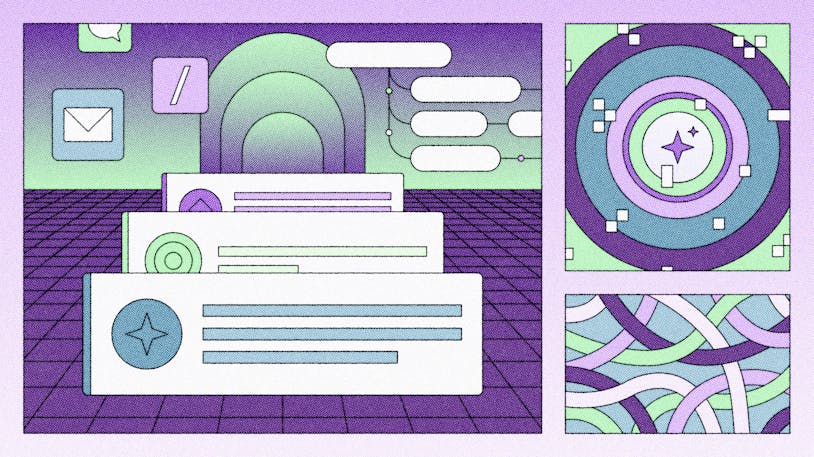Benefits of AI in Customer Service: 4 Ways AI Can Help


If you’re feeling like there’s a new AI-powered tool around every corner these days, you’re not alone.
Like Furbies in the late 90s or Uggs in the 2000s, artificial intelligence (AI) is everywhere. It’s gone so far that McKinsey dubbed 2023 “generative AI’s breakout year” in their recent report on the state of AI.
The increasing sophistication of AI like OpenAI’s ChatGPT has led many customer service leaders and online entrepreneurs to wonder how these tools can help their support teams, enhance their customers’ experiences, and boost their competitive advantage.
At the same time, leaders are wondering how to avoid common pitfalls in their AI usage so they don’t spend unnecessary money on flashy tools that won’t deliver.
Our evolving viewpoint on artificial intelligence in customer service
The evolution and launch of generative AI has sparked our own evolution of sorts at Help Scout.
It’s an exciting time, and it’s allowed us to experiment and build features like AI summarize and AI assist — features that save your support agents time and effort while also enabling them to strengthen relationships with your customers.
But we also recognize that AI isn’t a one-size-fits-all solution for customer service teams.
In the same way that a tailored shirt will fit you better than an off-the-rack one will, whether AI works for your organization depends on how well you understand your customers’ needs and your support team’s requirements.
In most cases, reaping the benefits of AI is highly dependent on how thoughtfully you integrate AI into your customer service tools and processes.
Sure, that tailored shirt might take more time, effort, and short-term expense, but the comfort you’ll feel and the better fit it gives will more than pay for itself in the long run.
What AI in customer service is (and isn’t)
Most AI tools used in customer service fall under the wide umbrella of machine learning (ML). They also usually fall under the slightly smaller umbrella of leveraging large language models (LLMs) that use natural language processing (NLP) to generate human-like text.
Let’s simplify: These are tools that can be given vast amounts of information, which they then use to respond to prompts and inquiries with human-sounding dialogue.
Although we use the term artificial intelligence when we talk about these tools, it’s important to understand that that’s more of a verbal shorthand than an accurate description of what’s happening under the hood.
Even the most powerful large language model currently available to the public (Open AI’s ChatGPT) isn’t actually artificial intelligence. It can only use the information it’s been given to predict the word that is most likely next in a sequence.
And while ChatGPT can sound very human, it’s not able to process and use information in the way that we humans do.
It doesn’t actually understand the information it’s been given, which means it can sometimes put that information together in ways that aren’t true or don’t make sense. Generative AI is incapable of true critical thinking or sound judgment.
And sadly, it’s not able to recognize when it’s made errors. This is called a hallucination, which is “a confident response by an AI that does not seem to be justified by its training data.”
We’re explaining this not to discourage the use of AI in your customer service organization, but to be clear about what AI is and isn’t capable of doing.
Generative AI can be an incredibly powerful tool when implemented and used correctly, but at the end of the day, it’s just another tool. When you don’t know what a tool is capable of, it’s hard to use it correctly.
That’s also why AI can’t completely replace human agents in most cases, especially in contextually complex situations or when customers need a high degree of trust in the information they’re being given.
How AI can help customer service teams (and improve your customer experience)
Now that we understand what AI is and what it can’t do, let’s talk about all the neat stuff it can do.
AI tools can be deployed in different places depending on your customer support needs:
In your customer conversations, assisting your agents in composing responses and sharing information.
When creating documentation, helping your agents capture visuals and draft articles.
Through AI-powered chatbots on your website or help center, providing 24/7, instant support for routine inquiries and issues.
In your analytics tools, identifying patterns and trends in product issues or customer behavior.
1. Using AI to improve customer conversations
We’ve all been there. Your customer is facing a gnarly bug, and you need to escalate their issue to another team.
You know the importance of a good write-up of the problem, but writing a high-quality bug report takes time that you don’t always have in a busy inbox.
Over 70% of customers think that customer support agents should work together so customers don’t have to repeat information. And who can blame them? We all know what it’s like to really need a problem fixed and to have to explain it over and over until you get to the person who can help you.
This is where generative AI tools like Help Scout’s AI summarize really shine. AI summarize can summarize a complex conversation in seconds, generating an easy-to-understand bullet point summary that allows a new agent or team to get up to speed effortlessly.
It means less time spent summarizing and more time spent solving customer problems.
AI tools can also enhance and even automate the quality of your customer conversations.
For instance, Help Scout’s AI assist acts like a personal writing assistant in email conversations, helping agents match your company’s support voice and style. It works side by side with your agent, helping them to quickly adjust the tone or length of a message.
Automating your quality assurance (QA) program using AI is another way to save time and continually improve your customer conversations. Many AI-powered QA tools — like Klaus or MaestroQA — automatically review conversations, conduct root cause analysis, and gauge customer sentiment.
When you have a small customer service team or you’re just getting started with your QA program, tools like these can be invaluable.
Supercharge your support with AI
At Help Scout, we’ve made using AI feel effortless. Learn more about how our AI features can save you time and energy on every conversation.
Learn More
2. Artificial intelligence in documentation and help centers
Nearly 70% of consumers will try to solve a problem themselves first, and customers prefer help centers over all other self-service options.
Many documentation tools have started using some form of generative AI to help your team. For instance, some can automatically take step-by-step screenshots as you work in your product (like Scribe).
ChatGPT can write first drafts or help edit your how-to articles and guides.
As with customer conversations, these tools are great for giving your agents a place to start. They eliminate manual work, so all your team members need to do is fill in gaps and double check outputs to ensure they’re accurate and consistent with the rest of your knowledge base.
3. Implementing AI in chat support
Customer service leaders have known for ages that chat support is usually a cheaper and more efficient way to provide support. Even better, many customers prefer live chat over support channels like phone or email.
An AI-powered chatbot can be an ideal solution for delivering personalized and instant support. AI chatbots allow you to provide basic customer support 24/7, and when they’re plugged into your other support tools, they enable automation and personalization at scale.
They make it easy for customers to quickly and easily manage things like orders, subscriptions, and refunds at their convenience.
There’s a catch, though: Chatbots have been around for years, yet generative AI is a relatively new phenomenon.
Prior to 2023, most of these so-called chatbots weren’t actually artificial intelligence. They weren’t generating responses to customers, and they often required significant work to set up and maintain.
With the launch of generative AI, many chatbot tools have started introducing the technology into their products. They’re becoming true chat “bots” — software that’s capable of understanding text inputs, then generating human-like responses based on the information they’ve ingested.
The moral of the story: If you’re evaluating a chatbot for your customer service team, make sure it’s actually powered by generative AI. This will reduce the effort involved in implementing and maintaining your tool, and it should also give your customers a smoother experience on their end.
4. AI-powered customer analytics and insights
AI tools are capable of analyzing huge amounts of data. It’s core to how they work. With the introduction of generative AI, these customer insight tools can now generate actionable summaries of trends, highlights, and concerns from your customer data.
Here’s an example: Your team is having thousands of customer conversations each day, yet it's hard to know what those conversations are about. You might find yourself feeling reactive, as if you’re always running around putting out fires.
An AI-powered analytics tool can reduce your reaction time, summarizing what your conversations are about far faster than any human could. For example, it might pick up on a product issue before your agents are able to recognize it’s a problem, or it might recognize that products from a certain factory are more likely to have manufacturing issues.
What to look out for when implementing AI in customer service
Artificial intelligence can be an incredibly powerful tool for customer service teams, but it’s a quickly evolving field. Ultimately, much of your success with AI will come down to vetting tools well and ensuring they’re a good fit for your team.
In other words, don’t just buy into the AI hype.
Here are a few things to be cautious about when starting your AI journey:
Data security — Any AI vendor you’re evaluating should be able to explain how they will be using and protecting the data their tool ingests, whether it’s your company’s data or your customers’. SOC 2 compliance, HIPAA certification, and other controls can bring peace of mind, but never hesitate to ask direct questions about how your data will be used.
Integration — You’ll always need to invest time to properly integrate AI into your processes and train your agents on how to effectively use it. This isn’t a step you can skimp on — remember that your AI is only as good as its training. This includes regular monitoring and optimization to ensure it’s behaving as expected.
Customer expectations — Managing customer expectations around your AI offerings is key. For instance, don’t promise an immersive chatbot experience if the bot will only be able to serve up articles from your help center. It’s also a good idea to be transparent about when customers can expect to talk to a bot and when they can expect to talk to a human (pro tip: always make it easy for them to talk to a human).
That leads us to our last and most important thing to look out for: over-relying on AI.
The vast majority of consumers, both in the U.S. (82%) and abroad (74%), still prefer to speak to a human. Our advice is to prioritize personal connections as much as possible. Your customers will remember that connection when it’s time to purchase again, and so will the friends and family they recommended your product to.
To boldly (and responsibly) go into the new AI frontier
AI is an exciting new frontier — more so because so many of the potential applications have yet to be discovered. Even so, the benefits of AI in customer service today are undeniable: more satisfied customers who are served quickly and effectively, plus happier agents who have more time to spend solving problems and learning new skills.
We’re looking forward to being your companion on this journey — that’s why we’re building thoughtful AI-powered features that only improve your customer conversations.
Sign up for a free trial of Help Scout today to try out a better way to talk to your customers.
The Supportive Weekly: A newsletter for people who want to deliver exceptional customer service.






